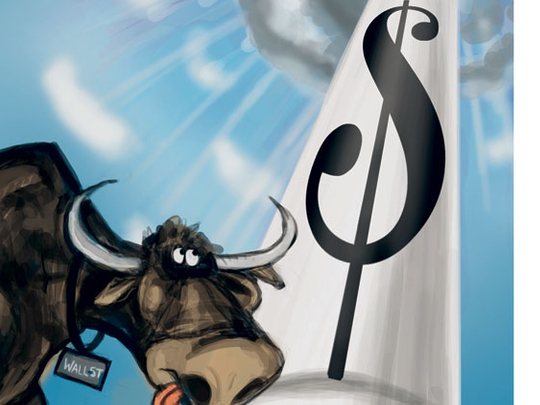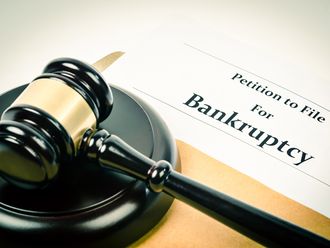
People, pundits and politicians looking for financial-crisis culprits should turn their sights to the professors who bear so much responsibility for it.
To borrow a phrase from professor Burton Malkiel, a random walk down Wall Street reveals that some of its biggest disasters have come from ideas hatched in the ivory tower. The next one may come from Lord John Maynard Keynes, now in fashion as the US government goes on a spending binge.
"Madmen in authority, who hear voices in the air, are distilling their frenzy from some academic scribbler of a few years back," said Professor Keynes, who died in 1946. "Practical men, who believe themselves to be quite exempt from any intellectual influence, are usually the slaves of some defunct economist."
I'll wager that his ideas will in time be blamed for the brewing disaster that's sure to follow the explosion in federal deficit spending during and after the financial meltdown. But that's for a future column.
Let's start with Edward Altman, a professor at New York University's Stern School of Business. He published a paper in 1985 showing that the default rate for bonds rated below the investment grade of BBB- (high-yield or junk bonds) was comparable to that of investment-grade issues. Michael Milken, the junk-bond king at Drexel Burnham Lambert, latched on to the same idea and began arranging bond issues to finance the corporate buyout boom of the 1980s.
Savings and loan disaster
Both men held the view that investors could boost their returns without increasing risk. This view played itself out in the savings-and-loan industry collapse in the late 1980s, fuelled partly by their investments in high-yield bonds. Among the most notable was Lincoln Savings & Loan Association, headed by Charles Keating, who invested heavily in Milken junk bonds that played a major role in the lender's failure. The Lincoln debacle also entangled five US senators, the so-called Keating Five, in a political influence-peddling scandal.
Another 1980s disaster with roots in academia was portfolio insurance, which used a computer model to dynamically hedge equity portfolios, selling stock-index futures contracts as prices fell. The firm Leland O'Brien Rubinstein Associates, headed by three academics, pioneered the strategy, which was blamed for contributing to the October 19, 1987, stock-market crash.
Though other forces played a part in that crash, the New York Stock Exchange invoked portfolio insurance when it adopted so-called circuit breakers, which halted trading if the indexes fell by a specified amount.
In the financial-market history books, the 1990s probably won't be remembered for the UK's return of Hong Kong to China on July 1, 1997, when almost everyone thought the province's currency would collapse in value on world foreign-exchange markets. It will be marked by the Thai baht's plunge the following day, triggering a round of competitive currency devaluations that reached Russia in August 1998, when the country defaulted on its debt.
One casualty was hedge fund Long-Term Capital Management, which mixed traders with mathematicians and college professors, including the two Nobel Prize laureates among its founders: Myron Scholes and Robert Merton. The fund arranged trades that took advantage of differences between interest rates and currencies in bond markets around the world, including emerging markets. It used the pricing model for which the two had won the prestigious award to mine for opportunities in options.
Grand as the models' theories were, it wasn't enough to prevent a $2.5-billion loss and a 22 per cent decline in the Standard & Poor's 500 Index. The Federal Reserve Bank of New York had to organise a rescue in September 1998 by the fund's bank creditors. The Fed itself was forced to cut its benchmark lending rate three times in a six-week span, including an unusual inter-meeting reduction, delivering a dose of preventive medicine to the US economy.
Academic economists have long had an inferiority complex, their social science being void of the certitude found in, say, chemistry. They have compensated with formulas to make their work seem more like a hard science.
There is a flaw in their approach. In the natural sciences, a postulated theory is dismissed with a single instance contradicting it. Not so in economics where a defunct theory is put on a shelf and brought out, dusted off, and used when it's back in fashion.
Seeing patterns
Academia's efficient-market hypothesis holds that prices on Wall Street's financial markets are a random walk and that past prices can't provide insight into the future. Yet, the professors are willing to use past data to calculate volatility and correlation for their models. For example, remember the mantra: House prices have never fallen, therefore they won't.
In the past decade, some scientists, certain of the infallibility of their constructs, attempted to model human behaviour in the financial markets with their math formulas — to disastrous effect.
In March 2000, as stock-market indexes were peaking, professor David X. Li brought us his Gaussian copula formula, which used correlations to price collateralised-debt obligations, securities once deemed too complex to value — and helping to set off the subprime credit bubble.
Next up, Keynes — but as I said, that's a whole column in and of itself.












